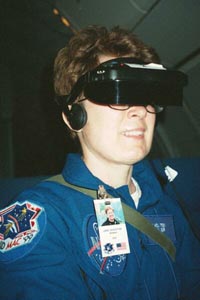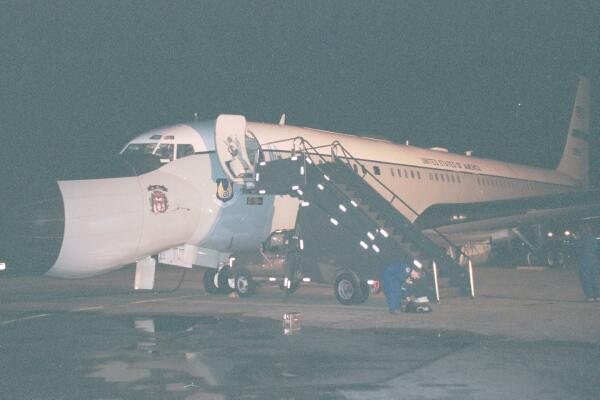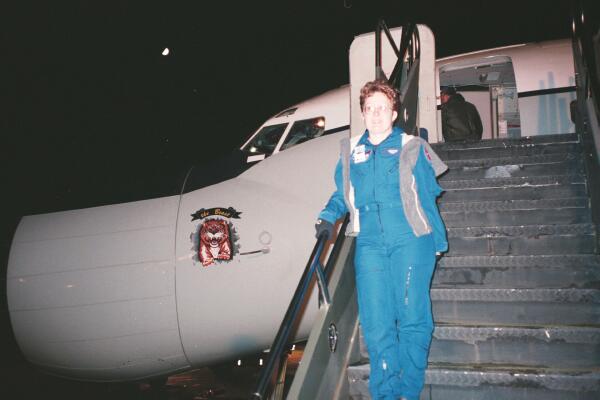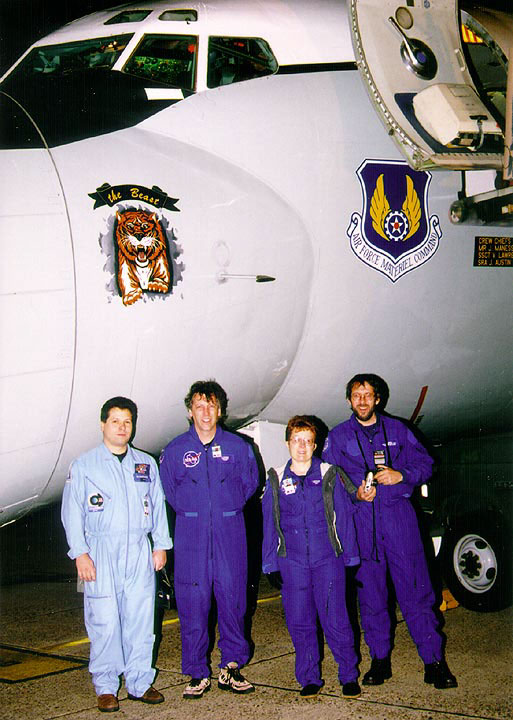November 1999: 10 days, 40 flying hours, 65 researchers and Air Force personnel, five members of the press, seven Air Force bases (four US, two UK, one Azores), 6 amateur astronomers, three aircraft, 15,251 meteors, one amazing memory. I’d like to thank Dr. Peter Jenniskens, the Leonid MAC principal investigator for inviting me to participate on this (and other) meteor missions over the past 11 years.
I was part of a six-person team of experienced amateur astronomers/meteor observers who were invited to fly around the world for 10 days, preparing for and then counting the Leonid Meteor Storm of 1999. We traveled from Moffat Field AFB near San Francisco over the San Andreas Fault to Edwards Air Force Base in Southern California for debriefing, badging, flight practice and setting our internal clocks a week of Leonid night flights. Then we flew across the United States and the Atlantic Ocean to England. Next, over Europe and Africa to Israel, back through the great Leonid storm to the island of Terceria in the Azores on the Mid-Atlantic Ridge. After a press conference, interviews and a celebratory dinner at Lajes Air Field we flew back to Patrick AFB in Florida for an end-of-mission party in Cocoa Beach, FL. Finally we crossed the US once again and flew right over Meteor Crater Arizona and back to Edwards AFB.
The entire crew flew on three aircraft, the ARIA, a Boeing 707, Advanced Range Instrumentation Aircraft. It has a telemetry antenna dish in the nose of the aircraft and four INMARSAT communication channels for internet and voice mail uplink, plus lots of windows, some installed for this mission. The second aircraft was the FISTA, a modified NKC-135E tanker called the Flying Infrared Signature Technology Aircraft, with 20 upward-looking window ports. The third aircraft, a C-130 provided airlift support for parts and emergency repair capability for the FISTA and ARIA aircraft. They also provided a global command and control platform for mission coordination.
Once the wheels were in the well, we headed for McGuire AFB in New Jersey to refuel for the trans-Atlantic flight. We took off at midnight from McGuire, and had a practice setup and observing run as we crossed the Atlantic. Seven hours later we landed at Mildenhall AFB near Cambridge. We counted 10 Leonids and 10 sporadics per hour during the practice run. We observed the Aurora Borealis and sprites, upward lightening strikes, thought to be induced by meteors.
On the second night flight we flew from England to Israel. We tested and calibrated our instruments, then observed and recorded 15 – 20 Leonids per hour, after making comets and giving talks at an elementary school near Lakenheath RAF Base.
On the third flight night we flew from Ben Gurion Airport in Israel to Lajes Air Field on Terceria Island in the Azores. This was the night we chased the Leonids and raced the sunrise. We observed the peak of the Leonid Storm of 1999 from 40,000 feet!
My team, the IMCU (Intensified Meteor Counting Unit) used intensified CCD cameras aimed out the windows of the ARIA. Some cameras covered the horizon to 30 degrees above, and some from 30-60 degrees. The cameras were connected to video headsets. As we viewed the intensified images we captured Leonids and sporadic meteors by mouse clicks reported to counting software. We observed and counted a ZHR (Zenithal Hourly Rate) of 2300 Leonids per hour. I personally observed 2700 Leonids on storm night alone. Our total was over 15,000!
On the fourth night from the Azores to Florida, we observed all night long again to collect data and measure the sporadic meteor count. Sprites and elves were captured by the airglow measuring camera on this night.
The final flight took us from Florida back to Edwards Air Force Base. We all looked out the windows in the bright daylight and saw the remnant of an earlier cosmic collision – Arizona’s Meteor Crater!
From the press:
Astrobiologists on a NASA mission to study the Leonid meteors were in the right place at the right time to study a rare natural phenomenon — a meteor storm.
At the peak of the storm, which occurred at 02:10 GMT, Nov. 18, 1999, the Leonid meteors were falling from the sky at a rate of 2,200 per hour. A meteor shower is classified as a storm when the rate exceeds 1,000 meteors per hour.
Sixty researchers aboard the $1 million joint NASA-Air Force mission hollered and hugged as the Leonids barrage intensified, and the jets traced slow circular routes over the Mediterranean between North Africa and Cyprus. Individual meteors soon multiplied to a half-dozen white streaks screaming over the horizon at 40 miles per second.
”I’m not on Cloud 9 – I’m above it!” quipped Jane Houston of the California Meteor Society, one of several amateur astronomers on the meteor-counting team. A total of 15,251 meteors were counted during the six-hour observation period on the overnight flight from Israel to the Azores.
Near real-time data on the number of meteors falling per hour was provided to NASA and the U.S. Air Force by a team of amateur astronomers who counted the meteors using virtual reality goggles and laptop computers. The meteor counting team was aboard the ARIA (Advanced Range Instrumentation Aircraft), one of two aircraft provided by the United States Air Force to support this mission. The data was sent from the ARIA, an EC-18 aircraft, to the ground via the TDRS satellite system. NASA and the Air Force are joint sponsors of the 1999 Leonid Multi-instrument Airborne Campaign.
Leonid Multi-Instrument Aircraft Campaign team, 1998-2002 (I’m bottom row, third from left)




[...] am is the peak, try early – before moonrise, before midnight. I have a soft spot for the Leonids from my years studying them from airplanes, or organizing ground based observing teams. Leonids are [...]
[...] Flying through the Leonid Storm of 1999 – from Edwards AFB [...]
[...] Flying through the Leonid Storm of 1999 Halloween Sidewalk Astronomy – Tradition! [...]